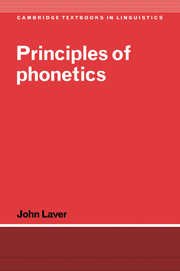Book contents
- Frontmatter
- Contents
- List of figures
- List of tables
- Preface
- Acknowledgements
- Introduction
- PART I General concepts
- PART II The analytic framework
- PART III Initiation and phonation
- PART IV Linear segmental analysis
- PART V Articulatory co-ordination and phonetic settings
- PART VI Temporal, prosodic and metrical analysis
- 14 The temporal organization of speech: segmental duration
- 15 The prosodic organization of speech: pitch and loudness
- 16 The metrical organization of speech: stress, syllable weight, prominence and rhythm
- 17 The temporal organization of speech: continuity and rate
- PART VII Principles of transcription
- PART VIII Conclusion
- Envoi
- Appendix I The phonetic alphabet of the International Phonetic Association
- Appendix II Index of languages
- References
- Index of names
- Subject index
14 - The temporal organization of speech: segmental duration
Published online by Cambridge University Press: 05 June 2012
- Frontmatter
- Contents
- List of figures
- List of tables
- Preface
- Acknowledgements
- Introduction
- PART I General concepts
- PART II The analytic framework
- PART III Initiation and phonation
- PART IV Linear segmental analysis
- PART V Articulatory co-ordination and phonetic settings
- PART VI Temporal, prosodic and metrical analysis
- 14 The temporal organization of speech: segmental duration
- 15 The prosodic organization of speech: pitch and loudness
- 16 The metrical organization of speech: stress, syllable weight, prominence and rhythm
- 17 The temporal organization of speech: continuity and rate
- PART VII Principles of transcription
- PART VIII Conclusion
- Envoi
- Appendix I The phonetic alphabet of the International Phonetic Association
- Appendix II Index of languages
- References
- Index of names
- Subject index
Summary
A statement was made in chapter 2 that there were only four perceptual domains available to the human auditory system for differentiating the elements of speech. These were the domains of perceptual quality, duration, pitch and loudness. The analysis offered in chapters 7–13 concentrated on those facets of the production of speech that modify the first of these domains – that of the perceived quality of speech at the subsegmental, segmental, intersegmental and suprasegmental levels. The present chapter will focus on the next of these domains, and will consider the temporal factor of segmental duration.
Chapter 15 will present an analysis of the third domain, discussing prosodic factors to do with the control of pitch and loudness, in speech melody and sonority respectively. Chapter 16 will then explore the question of how all four domains of quality, duration, pitch and loudness are integrated over a whole utterance, in which the interaction of syllabic, stress and rhythmic factors produce the metrical structure of speech. Chapter 17 will then consider the temporal organization of whole utterances, and will discuss matters of continuity and rate (or tempo) in speech.
The perception of duration
Duration itself is simply the amount of time taken up by a speech event, usually expressed in thousandths of a second (msec). Duration as such is thus a simple concept, though establishing adequate criteria for exactly where in time the start-point and end-point of an individual speechsegment might fall in an actual utterance, and therefore whether one segment is greater or less in duration than another, is often considerably more difficult.
- Type
- Chapter
- Information
- Principles of Phonetics , pp. 431 - 449Publisher: Cambridge University PressPrint publication year: 1994



